As Christmas dawns upon the Bandra villages of Sherly, Rajan and Malla, its residents recall striking memories from its vanishing past
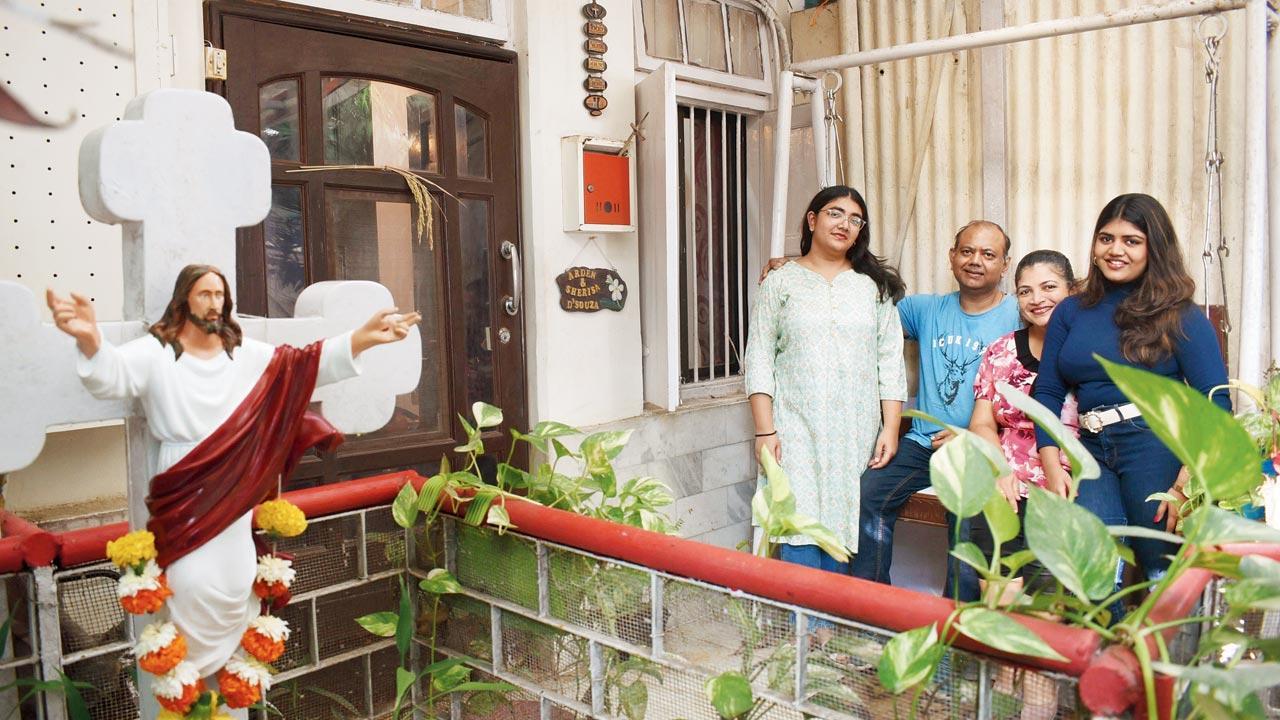
Arden D’Souza with his family at the entrance of the Rajan cottage where their flour mill also once stood. Pic/Sameer Markande
 I could be excused for believing Sherly Rajan Road is named for a person. That, as a six-year-old, was my notion of this slice of Salsette Island. Growing up on Hill Road, the East Indian villages familiar to us were Ranwar and Boran, in our backyard.
I could be excused for believing Sherly Rajan Road is named for a person. That, as a six-year-old, was my notion of this slice of Salsette Island. Growing up on Hill Road, the East Indian villages familiar to us were Ranwar and Boran, in our backyard.
ADVERTISEMENT
Awareness of the Sherly, Rajan and Malla bastions seeped in a little later in life. Today, I enjoy a studio apartment in one of the earliest buildings on Sherly Rajan Road, from the 1960s.
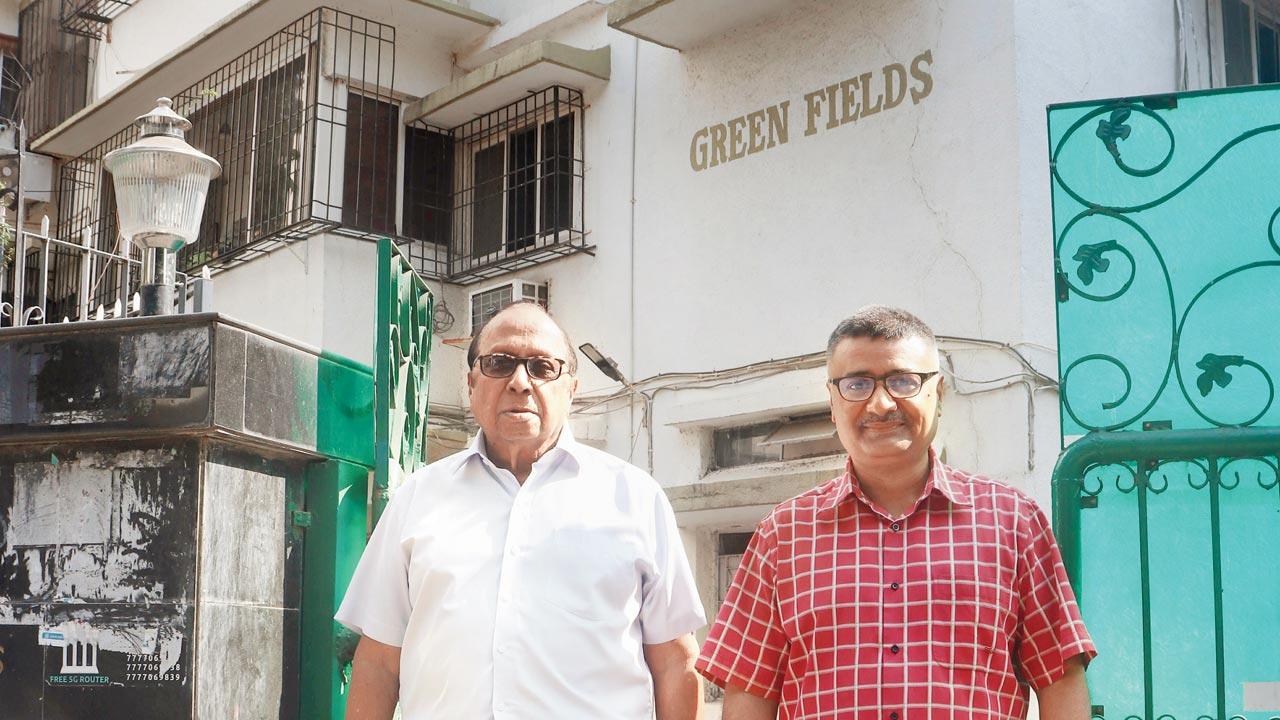 Rodney D’Mello and Dion D’Mello at the gate of Green Fields on Sherly Rajan Road. Pic/Anurag Ahire
Rodney D’Mello and Dion D’Mello at the gate of Green Fields on Sherly Rajan Road. Pic/Anurag Ahire
When Bombay was ceded to the British Crown in 1661, the Portuguese retained possession of Salsette, of which a prosperous portion was the agriculturally rich Bandra soil. Around the 1500s, it was divided into 24 villages—comprising farmers, toddy tappers, potters and fisherfolk selling one-anna pomfrets that were eagerly dried, fried or pickled. The locals converting to Christianity were called East Indians, identified distinctly from Catholic migrants to the city from Goa and Mangalore.
On Bassein (Vasai) falling in 1739, Salsette was transferred to the Marathas. Crushed at Panipat in 1761 by the Afghans, the Maratha defeat paved the way for the British to subsequently occupy Salsette.
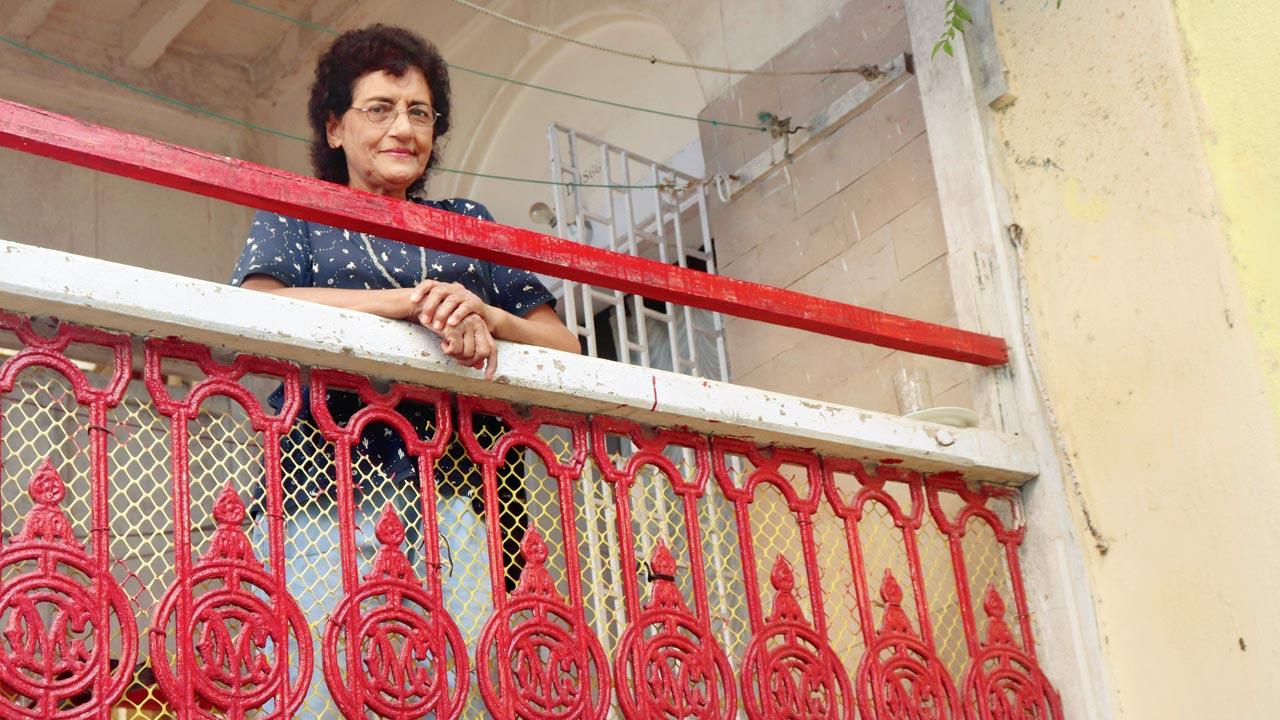 Yvette Gonsalves on the porch of House No. 26 in Malla. Pic/Anurag Ahire
Yvette Gonsalves on the porch of House No. 26 in Malla. Pic/Anurag Ahire
“Once there were green fields kissed by the sun,” extolled Fr Larry Pereira in his essay titled Bandra’s Beginnings, in the Bombay Local History Society magazine, Explorer. The Sherly-Rajan-Malla trio of hamlets, fringing St Anne’s Church built in 1858 on the west slope of Pali Hill, derive their names from words meaning “cultivators”: Xelalim, Rajana and Mallem.
Rodney D’Mello and his nephew Dion belong to one of the first families of Sherly, now living in aptly christened, three-storeyed Green Fields, it being once surrounded by sun-drenched tracts of paddy, paalak, bhindi, tomato and coconut. An intrinsic part of the community fabric, their landowner ancestors included Dom D’Mello, Rodney’s father, and Dom’s son Melville D’Mello, who was Dion’s father. Dom worked with Bennett auctioneers and played the mandolin. He was the trumpeter in Chic Chocolate’s orchestra. A refrigeration and air-conditioning engineer, Melville was an accomplished violinist and soloist for traditional Latin Requiem Mass.
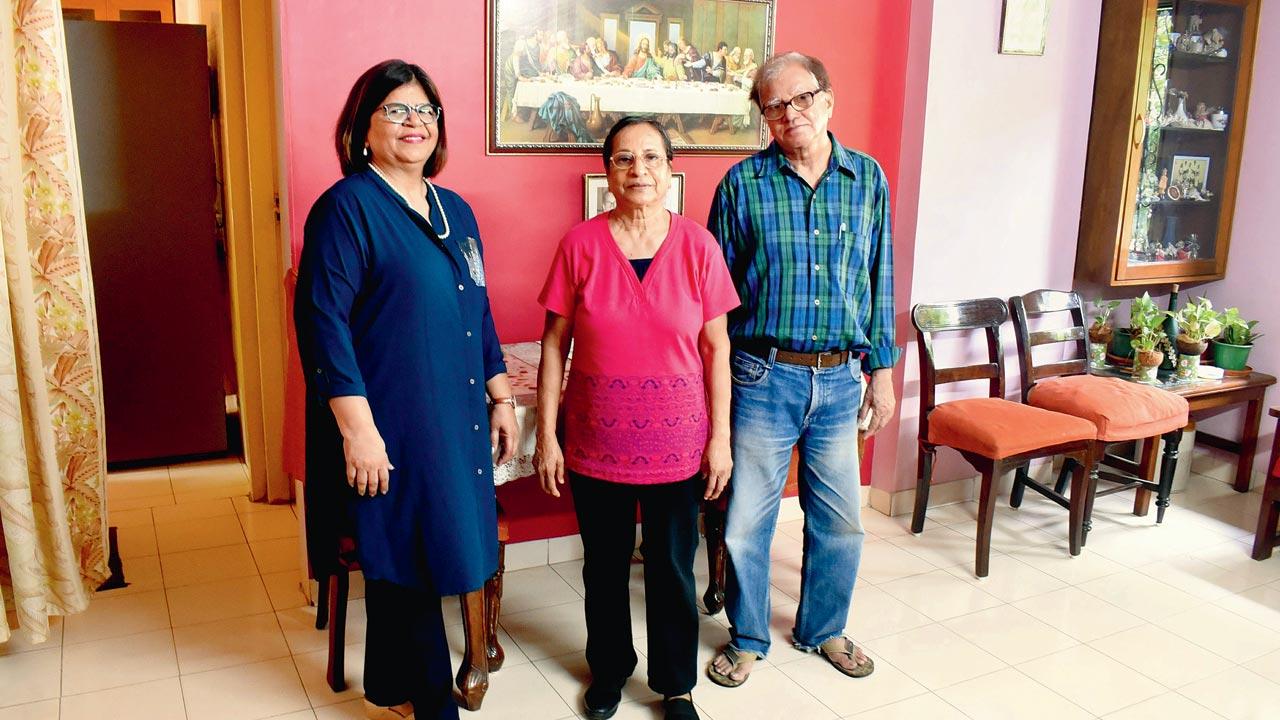 Clare D’Mello and Anne Gonsalves with their brother Connell in their Sherly village apartment. Pic/Sameer Markande
Clare D’Mello and Anne Gonsalves with their brother Connell in their Sherly village apartment. Pic/Sameer Markande
“We probably had the first fridge in the locality,” Rodney recollects. “I’d win carrom contests held under the village lamppost. We climbed trees and threw stones, knocking down mangoes and love apples. Dragging my bed to the balcony, I slept in the cool night air with my dog Tinker.”
Walking needle-narrow paths, Dion shows me the few surviving original structures in the area—low-lying, with typically solid load-bearing masonry holding up clay tile roofs. Louvres on twin-shuttered windows adjust to cut glare and encourage inward breezes. After No. 19, Sherly, now Dom Lucia building (combining Dom and his school teacher wife Lucy’s names), we stop at Mellow’s Home, inscribed with the date May 1, 1951, where the D’Mellos lived for a number of years.
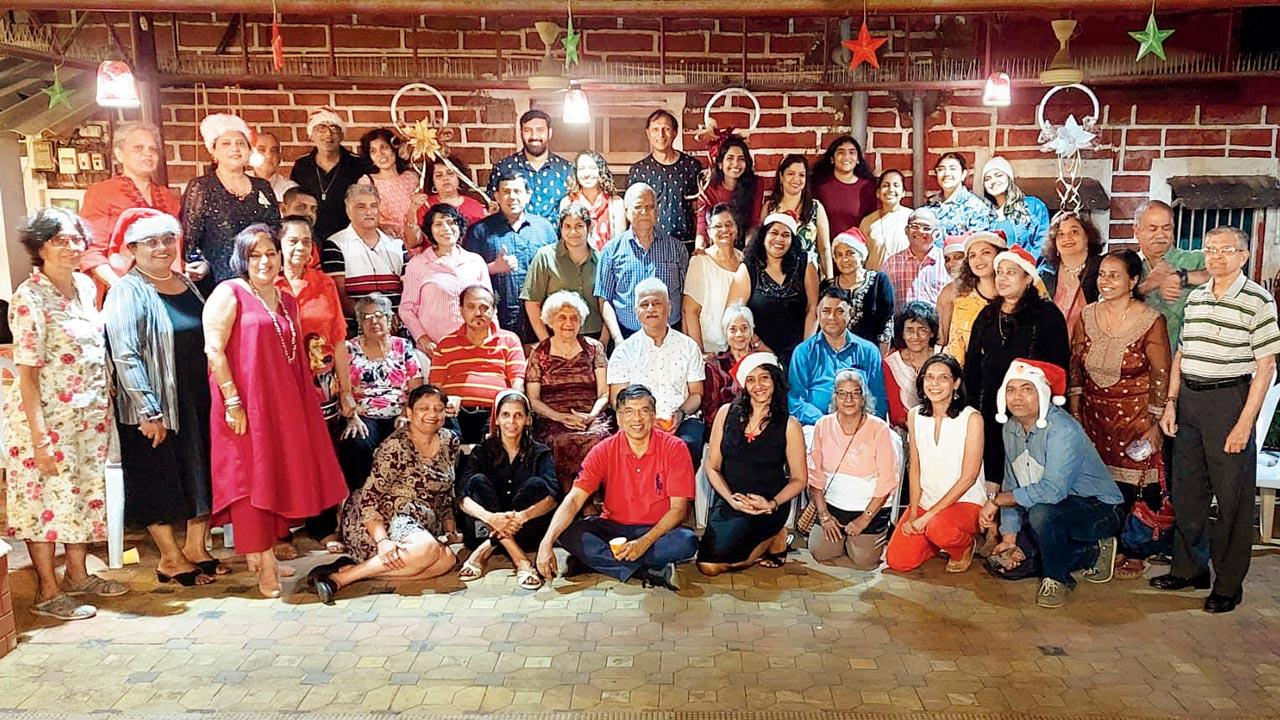 The Christmas party held at the Lawrence family home, in whose garden survives the sole tamarind tree of Malla
The Christmas party held at the Lawrence family home, in whose garden survives the sole tamarind tree of Malla
Our next halt, the Grotto of Our Lady, reveals an extraordinarily pretty replica of the Lourdes shrine. Commemorating Rev JI D’Silva, it is inscribed with another May Day date: May 1, 1914. Nearby was the house of “Master Wency” (Wenceslaus Fernandes), who offered commendable assistance to the St Francis Xavier School and St Anne’s Choir which he directed from 1938.
Amid the tempting aroma of just-baked gutli and oven-hot soft pao wafting with the scents of spicy prawn curry bubbling on stoves, Dion politely calls out “Emrita” through the porch trellis jaali of a Sherly cottage we peer into. Emrita D’Silva kindly loans a wonderful commemorative volume published on the occasion of the 150th anniversary of St Anne’s Church in 2008.
“When we moved to Green Fields in the early 1970s, Sherly was a small, sleepy locality,” remembers Gillian Castellino, daughter of journalist and historian Olga Valladares. “During Lent, close to midnight, the ‘Papias’ (penitents) went from grotto to grotto reciting an ad hoc mix of the Marathi version of the Rosary, the Portuguese litany and the Krista Purana. Announcing their presence with a rattle making a very particular sound, they were hooded, concealing their identity. Not supposed to see them, upon hearing the rattle, we were expected to be quiet, to respect their faith and courage to publicly repent sins.”
At No. 14 Sherly, sisters Anne Gonsalves and Clare D’Mello discuss the manifold significance of crosses dotting the suburb. Flagging spots in a maze of kachcha mud paths, these served as boundary locators. Of the vicinity’s main quartet, one near the additional police commissioner’s office off Carter Road marks the entry into Malla, the second indicates the entrance to Sherly, the third to Rajan and the fourth confirms the end of Rajan—and Bandra itself—before Khar starts. “This last one was constructed by our father Noel Gonsalves along with Fr Anthony Charanghat, editor of The Examiner,” says Clare.
As she describes Pali residents fleeing over the hill to Rajan and Sherly, to shelter from the deadly 1896 plague, Clare speaks of the protective “plague crosses” erected to ward off the scourge or in gratitude for saved lives. Parishioners still hold annual thanksgiving masses to St Roque, to whom a statue is dedicated at St
Anne’s Church.
With his roots in the East Indian coastal town of Uttan, north of the city, Joseph D’Souza from Felicia building, says, “What I’ve enjoyed for 35 years, my kids will never.” He refers to the terraced, ten-roomed home avatar of Felicia, designed by his architect grandfather JF D’Souza, who personally carried shore-skirting rubble to fill the 1940 plot he bought and named after his wife.
Until builders like Rizvi dominated the neighbourhood from the mid-1980s, the rural profile of this precinct punctuated everyday routines. Pigs and ducks were common fixtures and tinier creatures like rabbits were stuffed into the pockets of excited children for “show-and-tell” sessions at school.
“I’ve played in every single field, catching frogs for the soup we loved making from their legs,” says interior designer Arden D’Souza in Rajan village. Dwarfed by inexorable redevelopment, the compound of his villa, No. 33, used to share space with the family’s flour mill. His grandfather, Mathew D’Souza, an Uttan tiller, also built boats—a skill Arden’s father Barnabus inherited (their joint craftsmanship fashioned the wooden furniture in the living room we sit in). So, Kolis delivering fresh fish baskets to the home were no unusual sight. “Children bought five-paise lollies at Cheena’s ice cream factory and covered black-and-white television screens with colourful cellophane paper to get ‘colour TV’,” laughs Arden.
The presence of our women at the Olympics owes a great deal to a village dance. Mary D’Souza from Rajan became India’s first lady Olympian and Double International (track and field, and field hockey), selected for the 1952 Helsinki Games. Though she lacked coaching and finance—the government only extended airfare—the villagers organised a fund-raising dance. St Joseph’s, her school, had no grounds for her to practise at. “At night, I jumped over the wall, landing in St Andrew’s when girls weren’t allowed to train with boys,” Mary is known to have said.
The roadside shrine of Our Lady of Vailankanni, installed at 3A Rajan, sees devotees of varied faiths recite fervent Novena prayers. The Knox family of nine kids lived behind this grotto. One of them, Patricia Nath—a founding member of the Celebrate Bandra festival—has tales to tell of their pair of pet panthers and remembers each village had a kind of headman who worked for its welfare.
Onward to verdant Malla’s tracts of swaying palms and whispering tamarind trees. “Taken over by the BMC in recent years, the Malla Garden was a hillock with shrubs, banana trees and bullrushes. Our picnic spot as kids where we caught King George butterflies and dragonflies,” says Yvette Gonsalves in No. 26, a bungalow fascinating on two scores. The different dates on the cast iron-grilled verandah above its facade and the fact that its rear entrance has turned into the front, dictated by the route rickshaws take, behind the Bagel Shop.
Yvette was born in and continues to live in this villa that her father from Mangalore came to in 1939. This was the home philanthropist Manoel Gonsalves constructed in 1866, as the plaque in the picturesque portico reads. In 1909, he raised the first floor and moved upstairs with his third wife.
“Most houses had floors layered with cow dung collected from animals grazing freely. Our lane had red mud and, later, two feet of tar with the mud on the sides,” Yvette says, as we pass prominent gateposts. Like Dallas D’Silva’s cottage, where he supplies such delicacies as roast suckling (“Find us a crisper pig’s tail”, his regular customers challenge), stuffed chicken, sausages and sorpotel.
A busy dhobi ghat sits behind Manish Sea Croft building, earlier the bungalow of Braz D’Silva and his matchmaker wife Bidi, Yvette informs. “Till the 1960s, the washing well witnessed drownings. Dalda tins tied to their backs, locals learnt swimming in it.” Currently covered with concrete, the well leaves space only for pipes and a pump drawing water sans buckets and pulleys. Mushrooming chawls girdle the well, thriving with businesses beyond washing and ironing.
Jutting-out verandahs invite the outside in. Like unseen “Welcome” signs hung, I think, as octogenarian Irys Lawrence looks up from watering the lush plants in the garden of her home, L’Abode, with a friendly wave of her hand.
The noontime Hour of Grace has struck, on December 8, Feast of the Immaculate Conception. Every church, chapel and home has been fully immersed in 60 minutes of homily-powered worship.
We are back to happily breathing in rum-soaked Christmas pudding and catching the strum of a guitar or tinkling piano notes. Dessert always the East Indian forte (following meals flavoured with fiery “bottle masala”), thali coconut cake, rice atola pudding and boling apart, ’tis the season for ambrosial almond and cashew marzipan soon heaping festive gift trays. Who would want more than music and the food of love? All’s right with this world for now.
Author-publisher Meher Marfatia writes fortnightly on everything that makes her love Mumbai and adore Bombay. You can reach her at meher.marfatia@mid-day.com/www.meher marfatia.com
 Subscribe today by clicking the link and stay updated with the latest news!" Click here!
Subscribe today by clicking the link and stay updated with the latest news!" Click here!







